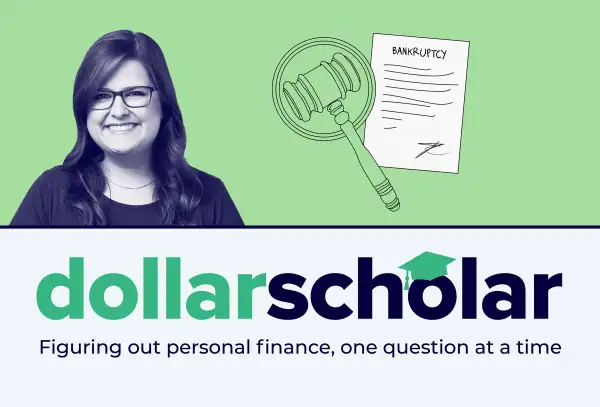Dollar Scholar Asks: Does Declaring Bankruptcy Mean I'm Totally Screwed?

This is an excerpt from Dollar Scholar, the Money newsletter where senior writer Julia Glum teaches you the modern money lessons you NEED to know. Don't miss the next issue! Sign up at money.com/subscribe and join our community of 160,000+ Scholars.
You know the villain in The Princess Bride, Vizzini, who’s always telling his henchmen how things are “inconceivable?” The possibility that someone followed them after kidnapping Princess Buttercup? Inconceivable. The fact that the Dread Pirate Roberts survived even though Vizzini cut his climbing rope? Inconceivable!
Remember how eventually, Inigo Montoya aka Mandy Patinkin gets fed up and delivers one of the movie’s most famous lines?
“You keep using that word,” he says to Wallace Shawn-as-Vizzini. “I do not think it means what you think it means.”
Well, I’ve come to find that extremely relatable. There are a lot of words I say without really grasping what they mean. “Blockchain” is one of them, and so is “cheugy.” And then there’s “bankrupt” — which I use casually all the time, as in “this upcoming Louis Tomlinson tour is going to bankrupt me.”
I’m vaguely aware that bankruptcy can be a way for people to bounce back when they’re in dire financial straits, but I’m unclear on the mechanics.
How does declaring bankruptcy work?
I asked Howard Dvorkin, chairman and CEO of Debt.com, to help me figure it out. He told me that bankruptcy is a way for people to get rid of their debt and “start fresh when all else fails.” That’s how the Supreme Court described it in a 1934 opinion, saying bankruptcy gives “the honest but unfortunate debtor” an opportunity to thrive “unhampered by the pressure and discouragement of pre-existing debt.”
(Note: I’m focusing on personal bankruptcy here, not the Toys ‘R’ Us kind.)
Declaring bankruptcy isn’t super common. In 2020, only about 523,000 people did so — the lowest number of filings since 1986, and down from 752,000 the year before. (Another note: This isn’t because everyone suddenly became financially stable. It’s probably because the courts were closed due to quarantine.)
There are two primary types of personal bankruptcy: Chapter 7 and Chapter 13. Dvorkin says Chapter 7 “is what most people think of when they imagine bankruptcy,” where the court sells some of my assets to pay off my debts. Chapter 13, on the other hand, is more of a reorganization where I repay some of what I owe through a court-ordered plan.
Chapter 7 is largely for low-income people. It’s fast, taking about 120 days compared to Chapter 13, which can take up to five years.
Both types get rid of unsecured debt, which includes credit card debt and medical bills but usually not student loans or back taxes, according to Sheereen Middleton, a bankruptcy attorney in Maryland. Bankruptcy can be a strategic move to eliminate that debt, “which would then leave you with a favorable debt-to-income ratio,” she adds.
“It’s something where it can literally change your life,” Middleton says.
In addition to being emotional, declaring bankruptcy is not cheap. Dvorkin says the process involves pre-bankruptcy credit counseling. He also recommends hiring a lawyer, even though it’s not required.
“You need someone experienced in your corner to do a lot of the legwork for you,” he says. “A small mistake on your part might leave you with some debt that an attorney could have gotten dismissed. This isn’t a cost you can cut around.”
Middleton says her company takes a person’s financial situation into account; she also takes on pro bono cases. Typically, though, attorneys’ fees hover between $1,000 to $3,000. Clients have to pay court filing fees, too.
There are other drawbacks to declaring bankruptcy, too.
Dvorkin says it stays on my credit report for 10 years from the date of filing for Chapter 7 and seven years for Chapter 13. That means lenders will see that I filed for bankruptcy every time I apply for a new credit card, mortgage or apartment. If I’m looking to get a Federal Housing Administration or VA loan, I’ll have to wait one to two years from the time my bankruptcy is discharged.
Middleton also explains that there are limits to how many belongings I can shield from the court. It varies by district, but the dollar amount often maxes out around $12,000. Retirement savings like 401(k) assets are usually protected, as well, so consulting with an expert is a good idea before you touch these accounts. She says if I have a lot of unprotected assets — like cryptocurrency, stocks or real estate with equity — I may want to look into other debt relief options.
The bottom line
Bankruptcy is more complicated than I realized. It can be a way for someone who’s deep in debt and can’t make ends meet to get back on the right track. That said, the clean slate comes with some pretty serious drawbacks, among them the cost of hiring a bankruptcy attorney and the long-term impact to my credit report.
Because of this, Dvorkin says people who declare bankruptcy should really put their fresh start to good use.
“If you go through all the financial and emotional stress of filing bankruptcy just to run up thousands of dollars in debt again, then it would have been a waste,” he says, adding that most people don’t. “Nobody should jump straight to bankruptcy as a debt relief option — but they shouldn’t dismiss it up front, either."
More from Money:
How to Pay off Debt: 5 Expert-Approved Strategies That Work
